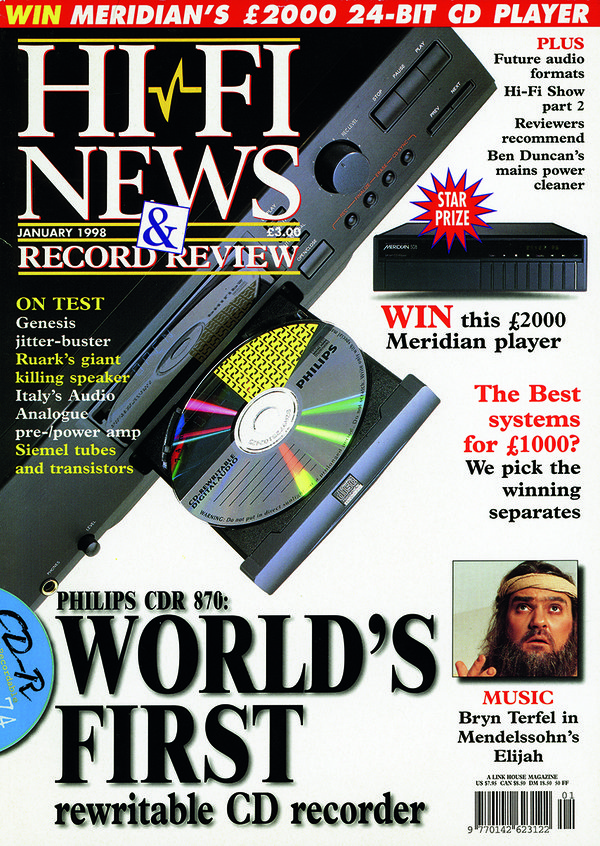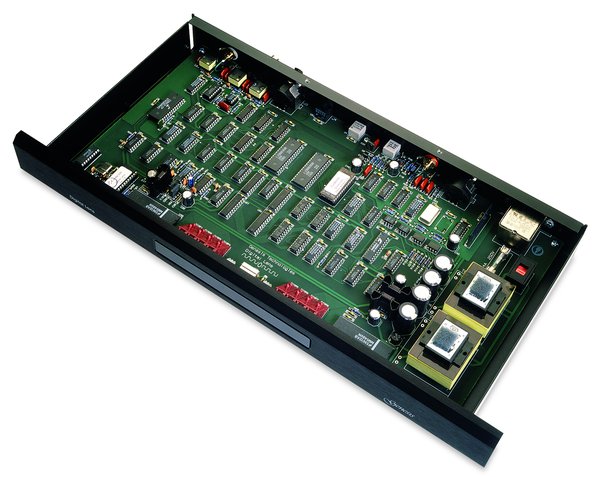Genesis Digital Lens

If the market for two-box CD transport/outboard DAC combinations has waned in recent years, then the same cannot be said for those little black boxes conceived to nestle in between. I refer, of course, to the add-on accessories often rather optimistically promoted as 'Jitter Busters'. Typically, these rely on a Crystal interface chip and one or two PLLs to suppress jitter while recovering the data clock.
Sample-rate converters have also been used, though the interaction of two asynchronous clocks brings its own compromises. Indeed, tests on some of these devices indicated there was as much jitter-generation as 'busting' taking place.
The Genesis 'Digital Lens' is a more comprehensive box of chips, and one that adopts a very different approach to the task of 'cleaning-up' digital data as it passes across the S/PDIF interface between CD Transport and DAC. But then, at £1800, so it jolly well should!

Speed Of Sound
Digital inputs are provided for electrical (phono and BNC) and optical (Toslink and AT&T) S/PDIF digital sources, with XLRs for AES/EBU interfaces. AES, coaxial and AT&T optical outputs are also provided. The simple front panel can indicate the active input, input lock, track timing, clock error in ppm (parts per million) of the source and which of the two dither options, D1 or D2, is selected. I'll return to this later.
All digital inputs are routed via a Crystal CS8412 interface receiver, which in addition to recovering the clock and audio data also provides direct access to the subcode. This channel and clock data is used to drive the Digital Lens' track timing display, while also allowing it to derive the deviation (in ppm) of the source's crystal clock. The 16-bit audio data, minus its subcode, is passed into a 500kB (0.5Mb) RAM buffer. This FIFO (First-In/First-Out) loop has sufficient capacity to prevent 'over-speed' data from overflowing while providing a breathing space for 'under-speed' data to be accumulated.

Under
the lid can be seen
two transformers,
one powering the
output circuit, the
other the rest of
the unit. Two
microprocessors
are used, one
handling the
display and the
remote control,
the other the
audio processing.
As for the RAM,
this comprises two
large chips
Word Up
Crucially, whatever the rate of incoming data, the data output by the FIFO buffer is precisely regulated by a highly stable reference: Genesis's TCO (Temperature Controlled Oscillator). Genesis specifies a ±5ppm accuracy for
this internal clock, which was met in this sample at just -3ppm. These days, CD player clock errors typically vary from 5-300ppm, though this in itself has no direct bearing on jitter performance.
Once re-clocked, the data is subject to proprietary DSP, where its word-length may be increased to 20-bits (the remote also has a button marked '18-bit' but this seems inoperative) and subject to additional dithering. There is no interpolation of audio data in Genesis's 20-bit mode. Instead, a triangular-distribution dither is tacked on to the 16-Bit audio data as 17, 18, 19 and 20-bits, extending the word-length.
The D1 dither option cannot be used in conventional 16-bit mode, although the D2 option can. In this case, the same triangular-distribution dither is added to the 15th bit, while, in 20-bit mode, the D2 option adds dither to the 15th and 17-20th bits. The 16th bit is left untouched, presumably to ensure the safe throughput of HDCD-encoded data.
Finally, the audio data is recombined with the relevant L/R channel status and de-emphasis flags via a Crystal CS8402 digital audio interface transmitter. Fig 1 demonstrates the clean, square waveshape of this digital output with minimal ringing (1) and a good 7.5 nanoseconds risetime. The healthy 825mV peak-to-peak level and 78ohm source impedance will also ensure broad compatibility.
Plot Thickens
In a 'representative' test using Thorens' TCD-2000/TDA-2000 CD transport and DAC, the reference plot [Fig 2] is obtained from the Jitter Measurement Suite v3.2.1 and shows a huge 1790 picoseconds of jitter, which is largely accounted for by data-induced phenomena (red markers). Minor jitter components include hum-induced (brown markers), PSU-induced (darker blue markers), and jitter of unknown origin (purple markers).
Renewed Vigour
With the Genesis Digital Lens set to 16-bits and inserted between the TCD-2000 and TDA-2000's coaxial interface, there is a massive 92% reduction in data-induced jitter [Fig 3] from 1770ps (2) to just 149ps (3) (green trace = before, black trace = after). Interestingly, there is also a small but uniform increase in random background noise (4) and no attenuation of the noise 'hump' (5) detected with the reference.
The subjective impact of eliminating this data-induced jitter, however, is quite unmistakable in the renewed vigour and natural colour of the music. As a rule, data-induced jitter brings a rather grey pallor to the performance, which may sound neutral but also rather underwhelming.
Bermuda Triangle
In 20-bit mode with 'D1 dither' [Fig 4] the reduction in data-induced jitter is only marginally less impressive at 91% but there is actually a 65% increase in hum (6) and 45% increase in PSU-induced jitter (7), presumably picked up during Genesis's additional DSP. In practice, the impact of this will depend very much on the inherent levels of hum/PSU-induced jitter that are already present in the host D/A converter.
Moving on to analyse the D2 dither option in either 16- or 20-bit modes [Fig 5] reveals a fly in the Genesis Digital Lens' otherwise impressive ointment. In theory, a triangular distribution is achieved by combining the output of two separate random number generators. In this way, the probability of generating a '0' is highest and '1' or '-1' the lowest, leaving all points between to form the sides of the probability 'triangle'.
Yet by ignoring the 16th bit for HDCD's sake, the distribution of dither is no longer truly triangular, revealing a 'hole' that represents a fixed and repetitive element that causes distortion during D/A conversion, regardless of whether the data is HDCD-encoded or not.
In this instance, the Jitter Analyser separated 252 peaks, 99 of which were discrete jitter sidebands amounting to 1218ps peak-to-peak. Peaks of unknown origin accounted for 1101ps, though most of these were linked to two fundamental frequencies of 15.6Hz and 43.0Hz respectively. Only the 15.6Hz component was present in the original (reference) spectrum before the Digital Lens was introduced. So, rather than increase levels of noise randomly, the D2 option has produced a correlated pattern of peaks which, in subjective terms, may be less palatable.
Conclusion
It's unfortunate there's still a market for products such as these, but Genesis's unit is extremely successful at mopping-up other people's jitter when used in either 16 or 20-bit modes with the D1 dither option. Happily, those flaws that remain to colour the Lens may be avoided by resisting the temptation to press the button marked 'D2'. It's dreadfully expensive, then, but... it works!


















































